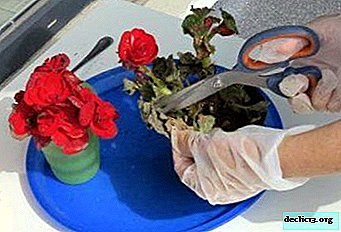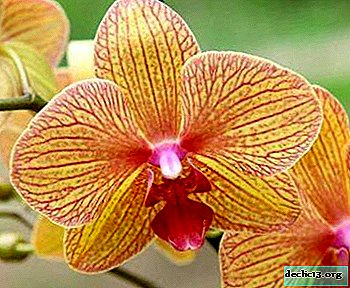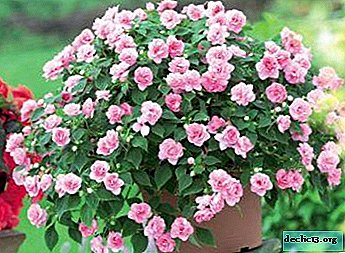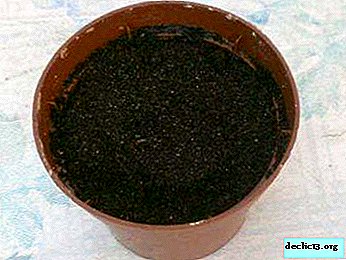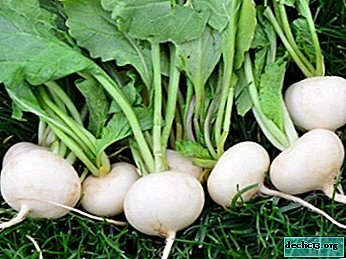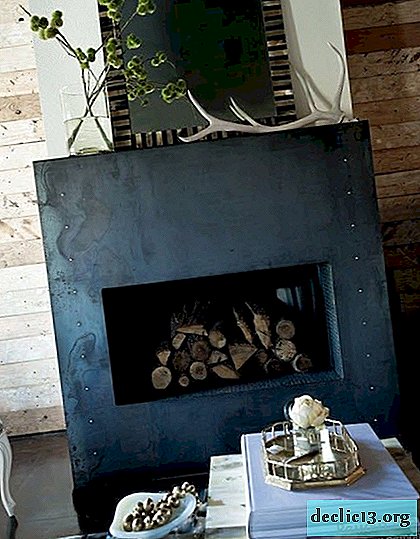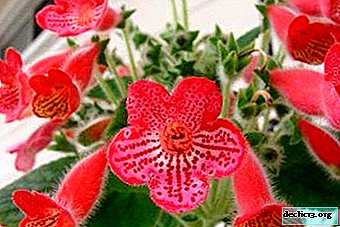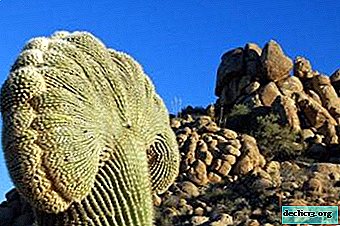Description, care features and photos of various varieties of meadow geraniums
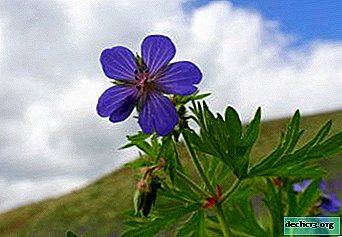
Meadow geranium is a grassy street perennial plant, one of the Geraniev family. It has several additional names - crane, stork, stolenets.
This plant is wild-growing and grows freely on forest edges, fields and meadows located in Europe, Central Asia and Siberia. Next, we will tell about the history of the origin of this species, as well as about the proper planting and subsequent care of the grassy beauty.
Botanical Description and History
According to historical data, the plant was bred by European breeders in the late 16th century. The plant has a rather thick and short rhizome, its length does not reach 10 centimeters. The leaves are characterized by the presence of a palm-split shape and are dissected into 7 parts.
reference. The flowers of the plant are presented in the form of both sexes and have five separate petals.Flowers are in the form of semi-umbrellas with petals 1.5 to 2 centimeters long, with a slight roundness on the outside. Calyx and peduncle are characterized by the presence of a fleecy surface.
The fruit of meadow geranium is presented in the form of a box. The lower part of the fruit contains 5 seeds, and the upper part contributes to their distribution. Seeds are able to spread to a distance of 2 meters.
Geranium has healing properties. More information about these medicinal properties and contraindications of meadow geranium can be found here.
Many people mistakenly believe that meadow and forest geraniums are identical. This is not so, these are different varieties of geraniums and they differ from each other in many ways. But the main difference is that forest geraniums always have protruding peduncles, while in meadow geraniums they are always tilted down (more information about forest geraniums can be found here).
Appearance
Meadow geranium is erect and can reach a height of 30 to 80 centimeters. The leaves and grass of the plant have a bright green color. The flowers of meadow geraniums are wide open, and have a bluish-purple color. At the base of the peduncle there are four acute lanceolate bracts.
Popular varieties and their photos
Below is a description of the most popular plant varieties and their photos.
Meadow geranium is divided into several different varietiesThe most popular of them are:
Summer Skye
A variety of meadow geraniums reaching a height of 60 to 90 centimeters. The bush is about 60 centimeters wide. The flowers have a terry texture and have a white color with a pinkish-purple tint. The central part of the flower is yellow-green. Occasionally there are varieties of the variety with light blue flowers and a white central part.

Black Beauty
A variety characterized by the presence of large lilac flowers with thin white veins. The leaves are carved, red-brown in color. In height, it can reach up to centimeters.

Plenum Violaceum (Latin)
A variety of meadow geraniums that reach a height and width of 60 to 90 centimeters. Terry flowers with a purple color in their texture.

Double jewel
A variety of meadow geranium, first discovered in the Netherlands. Terry flowers to the touch, characterized by the presence of white petals and a violet-blue base.

Rules, Tips and Planting Instructions
A few days before planting meadow geranium in the soil, you need to prepare pits for planting. As a rule, this plant has rather long roots, so the pit should be deep. The depth of the pit is calculated depending on the length of the roots and should be 20 centimeters more than the longest of the roots present.
Attention. The distance between each bush of geraniums should be from 25 to 30 centimeters, this will enable the roots to develop in breadth.Fertile soil is poured into the middle of the pit in the form of a cone, which can be purchased at a gardening store, and the roots of the plant are neatly laid out on top of it.
After placing the plant in the pit, it is covered with earth, and then irrigated. If you want to immediately fertilize the plant, then, most importantly, do not use manure that has not yet been rotted.
Lighting and location
An ideal landing site would be a site with good lighting, but the plant should be protected from direct sunlight, and for this it is advisable to plant it at partial shade. As a place of landing, you can choose flower beds, pots, borders.
Soil requirements
Due to the fact that the natural habitat of meadow geraniums is fields, meadows and forest edges, the plant will need moderately moist soil rich in humus. If such soil is not available on the site, then you can purchase it in a gardening store.
How to care?
 Caring for meadow geraniums does not require much time and effort.. The main thing is to carry out timely and high-quality weeding of the plant. The ideal period would be the beginning of May, when only a small number of leaves are present on the plant.
Caring for meadow geraniums does not require much time and effort.. The main thing is to carry out timely and high-quality weeding of the plant. The ideal period would be the beginning of May, when only a small number of leaves are present on the plant.
In the process of weeding, it is also recommended that the soil be loosened, since air should enter the roots of meadow geraniums. If there is no time for loosening the soil, then it is possible to plant low-growing crops between geranium bushes and mulch the soil immediately after planting this variety of geranium. This will reduce the need for loosening the soil.
Particular attention should be paid to timely watering, since meadow geranium does not tolerate drought very well. At the same time, it is also not worth watering the plant excessively too, since root decay is possible.
Tip. After flowering the plant, you can trim it, but this is not necessary, since the plant also grows well without this procedure.The plant grows very quickly and eliminates all weeds, so for 10 years it can not be transplanted and not rejuvenated. Cover the plant for the winter is not worth it, because it suffers well enough below freezing temperatures.
Common Diseases and Pests
Meadow geranium is quite resistant to the effects of diseases and pests, so they affect the plant only in very rare cases. For example, at too high temperatures, spider mites can appear in the sinuses and internodes of leaves. To get rid of them, you need to purchase any systemic acaricide.
Snails and slugs may appear, but their presence practically does not harm the plant. To get rid of them, you can use special preparations or clean them with your hands. As for diseases, the most common among geraniums is powdery mildew, but it is quite simple to overcome it using a solution of Bordeaux mixture.
Propagation Features
There are two ways to propagate meadow geraniums:
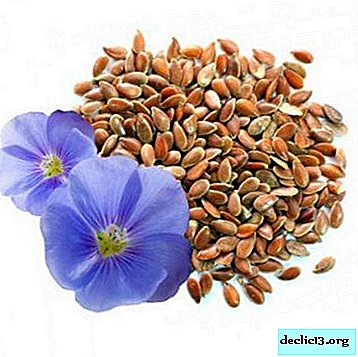 Using seeds. This method of propagation is very laborious and it is far from always possible to preserve the characteristics of the variety. At the same time, this variety of geraniums is able to propagate by self-sowing, which is also not very good, because plants can grow in inappropriate places.
Using seeds. This method of propagation is very laborious and it is far from always possible to preserve the characteristics of the variety. At the same time, this variety of geraniums is able to propagate by self-sowing, which is also not very good, because plants can grow in inappropriate places.If you decide to use this method of propagation, then you need to use only fresh seeds and you can expect them to bloom only after a year.
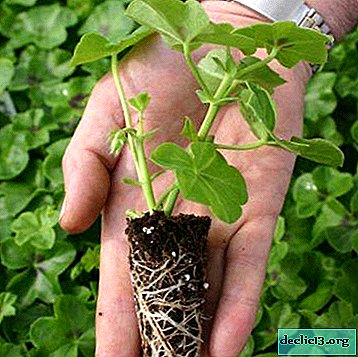 Vegetative propagation method. In this case, part of the adult geranium bush is separated and transplanted into pre-prepared pits (it should be remembered that this method of reproduction should be used only at the beginning of spring).
Vegetative propagation method. In this case, part of the adult geranium bush is separated and transplanted into pre-prepared pits (it should be remembered that this method of reproduction should be used only at the beginning of spring).Before planting the bush, in a prepared hole you need to pour a mixture of compost and peat. Immediately after transplanting the plant, it must be constantly watered. After a month after a plant transplant, it should be fed.
Agricultural cultivation
No agricultural technology required to plant meadow geraniums in the soil. It is enough to use such familiar garden tools as a pruner, shovel, bucket, watering can.
Meadow geranium is a plant that will decorate any garden plot, and thanks to its not pickiness, special efforts to care for it will not be required. The main thing is timely watering.

 Using seeds. This method of propagation is very laborious and it is far from always possible to preserve the characteristics of the variety. At the same time, this variety of geraniums is able to propagate by self-sowing, which is also not very good, because plants can grow in inappropriate places.
Using seeds. This method of propagation is very laborious and it is far from always possible to preserve the characteristics of the variety. At the same time, this variety of geraniums is able to propagate by self-sowing, which is also not very good, because plants can grow in inappropriate places. Vegetative propagation method. In this case, part of the adult geranium bush is separated and transplanted into pre-prepared pits (it should be remembered that this method of reproduction should be used only at the beginning of spring).
Vegetative propagation method. In this case, part of the adult geranium bush is separated and transplanted into pre-prepared pits (it should be remembered that this method of reproduction should be used only at the beginning of spring).
